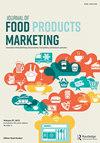健康意识和体重对青少年健康食品广告认知的影响
IF 2.4
Q2 BUSINESS
引用次数: 2
摘要
摘要:本研究采用细化似然模型的框架,探讨了健康意识对12-17岁青少年健康食品广告评价的激励作用。另外,该研究还调查了健康意识较低的年轻人是否会将广告中的人物形象作为评价食品的外围线索。数据证实,那些健康意识较低、身体质量指数较高的青少年,如果相关人物瘦,可以鼓励他们喜欢健康食品。虽然身体积极运动通过鼓励更胖的模特的形象,在限制对超重的偏见方面取得了进展,但这些努力可能对最需要有效宣传健康食品的受众有害。相反,本研究通过断言身体大小的外围线索可以更好地向超重青少年推广健康食品,从而为营销文献做出了贡献。本文章由计算机程序翻译,如有差异,请以英文原文为准。
An Exploration of health-consciousness and Character Weight as Factors Influencing Adolescents’ Perceptions of a Healthy Food Ad
ABSTRACT Using the framework of the elaboration likelihood model, this study investigated the role of health-consciousness as a motivator for adolescents, 12–17 years of age, to assess a healthy food advertisement. Alternatively, the study investigated whether lower health-conscious youth would use the appearance of characters in advertising as a peripheral cue to evaluate the food. Data confirmed that those adolescents lower in health consciousness, and higher in Body Mass Index, can be encouraged to like a healthy food if the associated character is thin. While the body positivity movement is making advances in limiting bias against overweight by encouraging the portrayal of heavier models, these efforts could be detrimental to the audience most in need of effective promotions for healthy foods. Instead, this study contributes to the marketing literature by asserting that the peripheral cue of body size can be used to better promote healthy foods to overweight youth.
求助全文
通过发布文献求助,成功后即可免费获取论文全文。
去求助
来源期刊

Journal of Food Products Marketing
BUSINESS-
CiteScore
5.70
自引率
6.90%
发文量
17
期刊介绍:
From food promotion and advertising through new food product development and consumer behavior research, the Journal of Food Products Marketing provides timely, practical articles that keep food marketers on the cutting edge of their profession. The journal includes refereed research studies as well as opinions, guidelines, and speeches by practitioners that contribute to the better practice and understanding of food marketing. The journal provides a single forum for both food marketing academicians and food marketing practitioners.
 求助内容:
求助内容: 应助结果提醒方式:
应助结果提醒方式:


